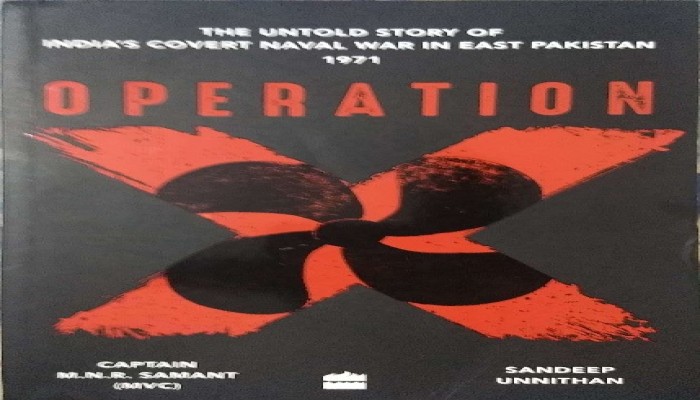Operation X – The Untold Story of India’s Covert Naval War in East Pakistan 1971
- In Book Reviews
- 08:36 AM, Nov 23, 2020
- Venkatesh Kikkeri
“And if war comes again, I assure you that we shall carry it right into the enemy’s biggest ports like Karachi; I know this harbour quite well for I started my career working there. And you have my word, that given the opportunity, the Indian Navy will make the world’s biggest bonfire of it”.
-Admiral S M Nanda in an interview to the Blitz, a Bombay newspaper on 15th March 1969
The above determined resolve by Admiral Nanda was prompted post 1965 Indo-Pak war wherein the Indian Navy was not deployed in an offensive role. He was Rear Admiral then. The Indian Navy sat out of the 1965 war, with the political class assigning them the safety of Indian merchant shipping and the sanctity of the Indian coast with an aim of not widening the war.
True to his steely resolve, Admiral Nanda led the Indian Navy in bombing the Karachi port to smithereens during the 1971 Indo-Pak war. This was an overt operation conducted by the Indian Navy. There was also a covert operation on the Eastern Front of India executed by the Indian Navy led by Admiral Nanda and personally approved and regularly monitored by none other than Indira Gandhi, the then Prime Minister of India. This covert operation was code named “Operation X” or Naval Commando Operation (X), NCO(X) in short.
The secrecy of the Operation which till now was either not known or the papers of which were filed away in the steel cupboards of Naval Head Quarters with their doors painted with a red X is revealed by Captain M N R Samant and Sri Sandeep Unnithan in their gripping book “Operation X – The Untold Story of India’s Covert Naval War in East Pakistan 1971” published by HarperCollins Publishers India.
The book is all the more riveting since the details about the operation is narrated by then Staff Officer (Naval Operations X) who is none other than Captain M N R Samant himself, the co-author of this book, who oversaw all covert naval operations in the East.
This covert operation was hatched somewhere in March/April 1971 in the backdrop of East Pakistan witnessing a genocide perpetrated by the Pakistani Army resulting in a huge influx of refugees into India and war clouds looming large over the India’s Eastern and Western Sectors. The operation had to be covert since war hadn’t been formally declared during March/April 1971. Admiral Nanda had an able ally in Captain Mihir Kumar Roy.
Vitality of the waterways inside East Pakistan can be understood from the fact that the sustainability of the entire military garrison of East Pakistan – cantonments of Dacca, Comilla, Sylhet, Jessore, Rangpur, Rajshahi, Bogra, Khulna and Chittagong – depended totally on the waterways and the sea routes. The waterways were akin to oxygen for East Pakistan’s military supply and logistics.
It was very clear to the Indian Navy that to realise the Indian maritime military objectives in East Pakistan, the disruption of the waterways was a must. This was an operation in the world’s largest delta, the extensive riverine network of Bangladesh to completely paralyze the ports, harbors and inland waterways inside East Pakistan.
To achieve the navy’s objective Captain M K Roy built an underwater guerrilla force through Operation Jackpot. The underwater guerrilla force was extensively trained in the use of explosives to totally destroy vital port and inland waterway infrastructure, ship damage, destruction of ferries, pontoons and barges apart from blocking waterways and channels, removing navigation aids in channels, cutting anchors and cables and damaging fuel installations, endurance swimming, diving and explosive handling expertise needed by marine commandos.
The authors reveal that a total of 457 commandos were trained by the Indian Navy experts. A group of eight Pakistan Navy deserters formed the nucleus of this trained underwater guerrilla force. These eight deserters were on the submarine PNS Mangro which was undergoing sea trials at French naval base of Toulon. India enabled their escape and trained them to form the core of the underwater guerrilla force.
The book is racy and describes graphically the entire operation that crippled approximately 100,000 tons of shipping with scores of ocean-going ships, ferries, river crafts, gun boats either sunk or very badly damaged. The enormous damage caused by the underwater guerrillas who were so meticulously trained by the Indian Navy prompted Henry Kissinger, United States National Security Adviser to comment to President Richard Nixon on 5th November 1971 thus:
“Indira Gandhi didn’t know about the guerrillas in East Pakistan…. One thing that really struck me, the blown up (ships) and that takes a lot of technical training. I wonder where they got that…”
In 1971, Operation X was the largest such operation since the Second World War. The success of this operation paved way for the carrier borne attack aircraft of the Indian Navy to carry out their offensive role successfully. If in 1991 the United States used their carrier borne aircraft to pulverize the Iraqi forces, India had to a limited extent resorted to the same tactics with the help of INS Vikrant, her aircraft carrier in the waters of Bay of Bengal. For this to happen the success of Operation X played a vital role. As Admiral Nanda later noted, the Indian Navy had established its relevance.
As the authors point out, the Indian State had proved it was not entirely a stranger to irregular warfare, which it had been at the receiving end of since 1947. This book is a must read for every Indian proud of their armed forces. This book is also an authoritative military history, extensively researched and narrated in an enthralling fashion.
Image provided by the author.
Disclaimer: The opinions expressed within this article are the personal opinions of the author. MyIndMakers is not responsible for the accuracy, completeness, suitability, or validity of any information on this article. All information is provided on an as-is basis. The information, facts or opinions appearing in the article do not reflect the views of MyindMakers and it does not assume any responsibility or liability for the same.







Comments